1950
Buick "XP 8 Le Sabre" (special order # 9830) another Buick
dream car that inspired many later Cadillac models. It was unveiled at the Paris
Salon in December 1950 [and modified in 1953]. It cost $500,000 to build. SIA16
{***}, MT, 100th Anniversary., p.10. As it was shown mainly in 1951, photos
appear in that dream car section.
Cadillac Styling Studio (USA) designer's drawing of a proposed
roadster on Cadillac chassis, circa 1950
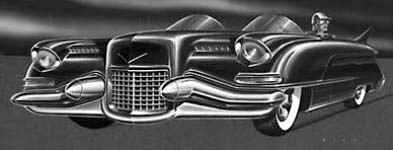
Image: Z. Taylor Vinson collection, courtesy
Hagley library and Museum, DE
Coachcraft (USA) special station wagon (drawings by Strother
McMinn) featuring 1/4-windows behind rear doors, electric tail-gate glass and
free-standing rear fenders. Photos SSA93, p.12
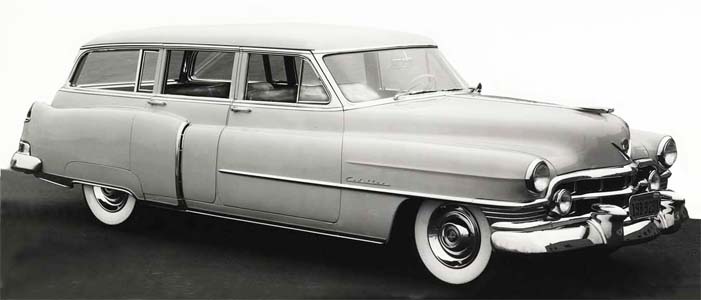
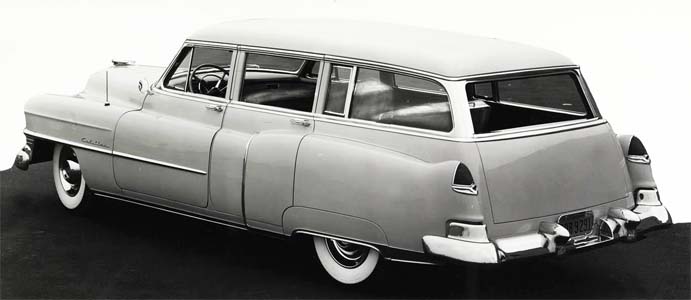
Coachcraft (USA) bullet-proof, armor-plated "60
Special" sedan for gangland boss, Mickey Cohen, featuring 1˝" thick glass all
round. Because of a quirk in California law, preventing a private party owning an armored
vehicle, the car had to be sold out of state. SS member Hollis Weihe heard of the
car having been later offered for sale in Tennessee. Photos SSA93, p.12. I got this from an enthusiast in New Zealand: There are other
interesting Cadillac's in the Southwood museum [NZ] including a '52 (I think)
that was ordered for the gangster Mickey Spillane [I think the writer meant Mickey
Cohen], but he never used it because the cops would not allow it on the road. It has
bullet scratches in the glass which I believe were caused by the police test guns at it to
test the strength of the glass, after they confiscated it. "Tony", a
visitor to the Cadillac Database Guest Book in April, 2003, says the car is currently on
show in the Len
Southward Museum, at Paraparaumu, NZ along with Marlene Dietrich's 1935 V16 town
car. Tony said that Cohen is reported to have "done some work" for both Al
Capone and "Lucky" Luciano.
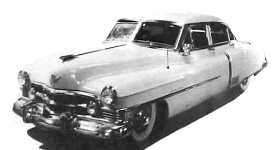 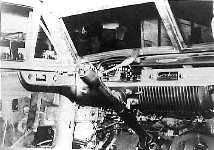
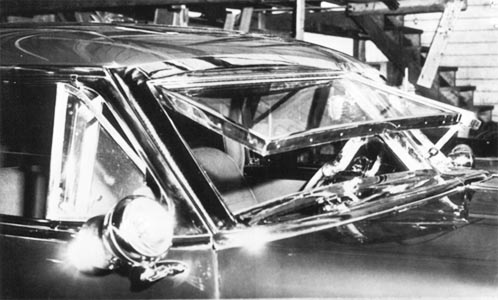
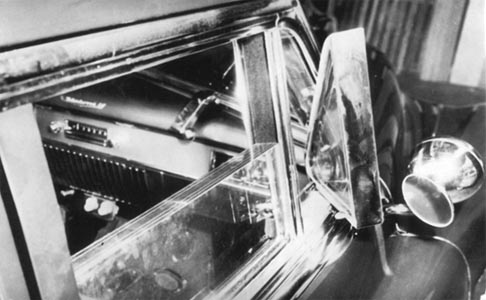
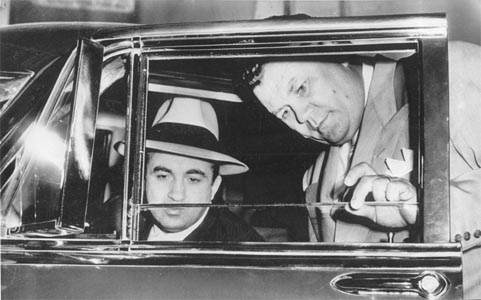
You can see the thickness of the
bullet-proof glass in the open vent window


These captions note were attached to the reverse
of these photo
[ Photos: Internet ]
Crossett, A.H. (USA, New Mexico) Beaming proudly, below, left, is
custom car owner A.H. Crossett of Artesia, NM. He built this roadster on the
120" Cadillac chassis using a stock 1950 Cadillac motor. The body consists mainly of
new parts from a 1950 Oldsmobile. The car is painted cream, with red leather upholstery.
Crossett built it, nights and Sundays, over a period of five months (source: Motor
Trend, May 1951)
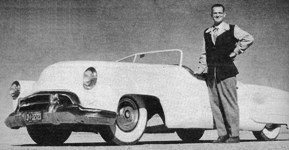  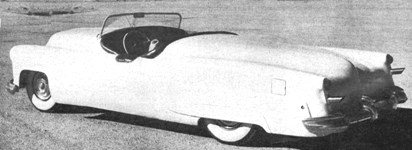
Info and images from Z. Taylor Vinson collection,
courtesy Hagley Library and Museum DE
Cunningham, Briggs (USA) The well-known racing specialist entered
two Cadillac-powered cars in the 1950 edition of the 24-hour Le Mans endurance race in
1950. One of them was a stock Series 61 coupe. The other was this special
barquette, nicknamed Le Monstre (the monster).
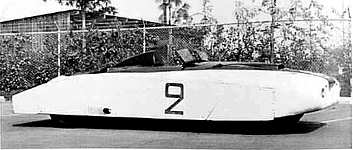 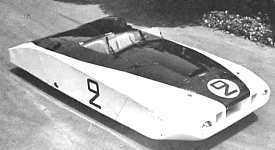
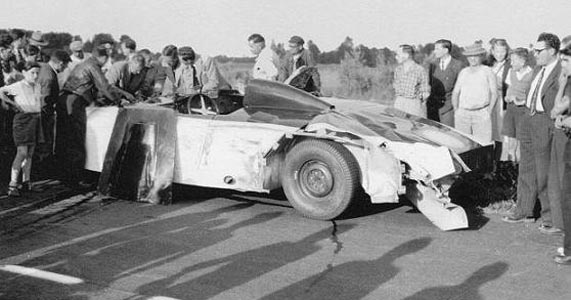
Despite this accident, Le Monstre
continued the race
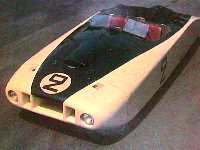
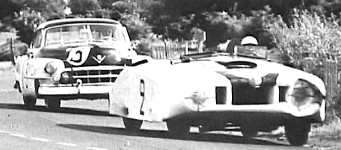 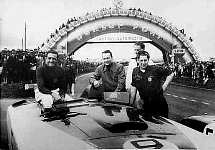
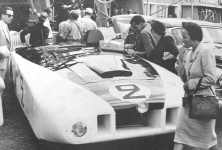 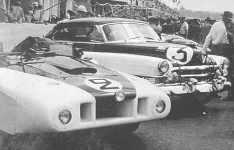 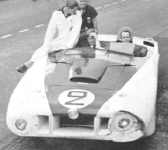
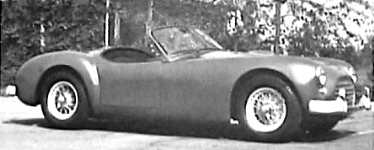
Derham (USA) formal sedan on Fleetwood 75 chassis, McC
p.288 (a similar car was built by Derham in 1951)
Derham (USA) formal sedan on Fleetwood 60S chassis, for the Duke
and Duchess of Windsor. Cadillac
enthusiast and CLC member from Minnesota, James Fredrick, informed me in May, 2006, that
he had acquired this other "custom" Cadillac which the Duke and Duchess used
during their frequent stays at their Waldorf Astoria Towers apartment in New York.
They apparently owned the car from 1950 to 1954. It has the typical Derham backlight,
which is oval and about the size of a football. Thanks for the pics, Jim.
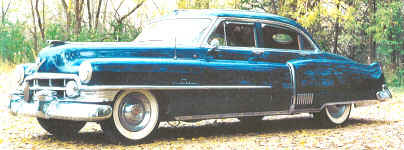
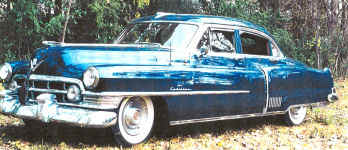
In the center of the roof, just above the windshield
frame, is what appears to be a second Cadillac mascot; in fact it is a blue
"taxi" light that apparently was switched on when the royal couple were
aboard the vehicle. Up front also is a shield surmounted
by some armorial bearings (probably those of the Windsors); the shield carries the
words "State of New York".
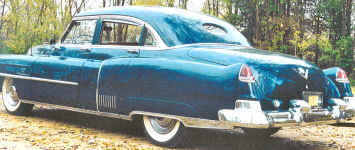 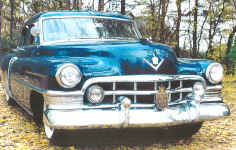
Only from the rear can you see the custom work done
by Derham; this car
was fitted also with a glass divider between the front and rear compartments
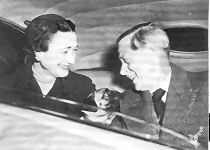
The royal couple with one of their pugs
Fleetwood (USA) (???) Cadillac Debutante with leopard
skin interior (SSA 1982, inside cover). Although I firmly believe that animal skins
should remain on the backs of their legitimate owners, I cannot omit a reference here to
the description of the Debutante convertible dreamed up by Cadillac's own advertising copy
writers: Since its premier showing in January Cadillac's "Debutante" has been
attracting nation-wide attention. Thousands have been awed by the striking originality and
beauty of the motor car masterpiece - the most luxurious automobile ever built by the
Cadillac Division [!!!]. The car is featured also in Life magazine for February 13, 1950
where it is headlined as the $35,000 Cadillac [Transportation, p.62].
The color was "Tawny Buff" (a gold-like hue) and is reported to have
featured gold-plated interior hardware.
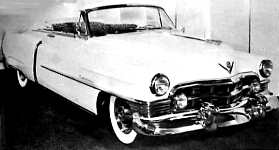
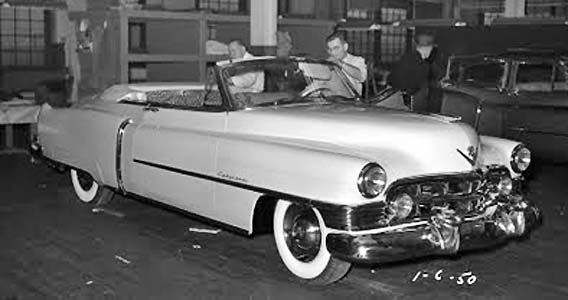
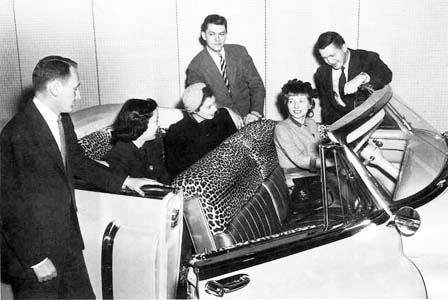 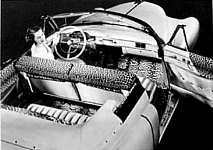
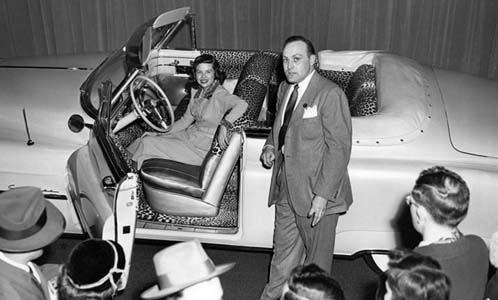
Left and center: At the New York show, in January,
the ladies could not keep their hands of the leopard skin
upholstery; this required the permanent presence of an usher to keep the fur
brushed smoothly
Right:
Cadillac's Debutante show car on display at the Chicago Auto
Show, 1950 venue
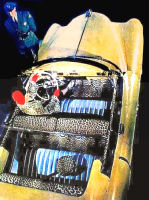
For many years designers have dreamed of creating a most unusually
appointed Cadillac, employing rare furs for interior body covering. This dream has become
a reality with the long lurking desire culminating in a leopard skin trimmed convertible.
The selection of leopard skin for this car was most fitting in
keeping with the character and tradition of Cadillac automobiles. Throughout the centuries
a particular distinction has been attached to the use of these skins as raiment or in
adorning living quarters.
Among many tribes the leopard is regarded with such awe that even the
mention of the name is taboo and the skins may be worn only by the supreme chief - as the
"Ingwe" or leopard has had a quasi-sacred character since its earliest
appearance in antiquity.
As perfect leopard skins are scarce, the greatest obstacle, as
pointed out by Don E. Ahrens, Cadillac General Sales Manager, was that of obtaining enough
for this undertaking.
Many months before the car was built a Detroit furrier was
commissioned to find the perfect specimens. This quest was fulfilled when he brought the
187 finest skins in the country to his establishment. After a careful examination it was
determined that fourteen approached the high quality of this car as closely as could be
obtained. Fur experts then studied the skins for many days to arrive at an exact match and
perfect laying of each piece.
The leopard skins covering the upper portion of the front and rear
seat backs, the upper side panels, and the complete floor in the front and rear
compartments give a sophisticated interpretation of primitive splendor.
These skins are those of the Somaliland leopard - the largest, most
ferocious, and yet the most beautiful species - found only on the East Coast of Africa.
For an unusual touch, two pieces of leopard tail were used to make
the robe cord - and it is easily understandable that a leopard claw should be added to the
ignition key ring - a whim of the designer's mood.
Only the stoic can study this creation without coming under the spell
of its primitive beauty.
So perfectly have these skins been prepared that it requires little
imagination to vision a leopard gliding cat-like through his native haunts - the smooth
flowing, muscular ripple belying the tremendous power of the predatory beast.
The quiet repose of the leopard skins on the car flatter masculine
ego and the thought of being surrounded by the gorgeous luxury of the rosette studded
skins titillates feminine imagination.
In brilliant contrast to the rosette studded leopard skins - lower
seat backs, cushions, and the covering of the lower sides and door panels is a shimmering,
opalescent, gray nylon satin.
The armrests are covered with iridescent gray leather. The note of
luxury set by the lavish use of rare furs is further highlighted by the richness of the
interior appointments. Every interior, unpainted metal surface is gold plated. No detail
has been overlooked, even the ignition key and key chain are in gold finish.
Typically Cadillac in that no detail has been overlooked, the
debutante's every desire is lavishly provided for in this aptly named car. A cigarette
case and memo list are concealed in the left front door panel. While, tucked away in the
opposite door is a lipstick and a miniature perfume atomizer [all previewing the
future Eldorado Brougham's complement of vanity items ?!?!].
In Tawny Yellow Buff the exterior of the "Debutante"
complements the Rufous Buff color in the leopard skins. In this exterior finish, the pearl
luster has been achieved by overlaying the base paint with a sprayed layer of miniature,
moon shaped fish scales - these are exceedingly costly, obtained only through a special
process that requires dissolving the larger portion of a fish scale leaving only the tiny
pearl essence.
1 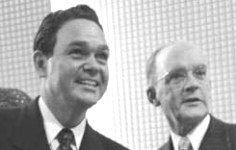 2 2 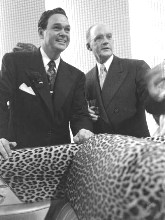 3
3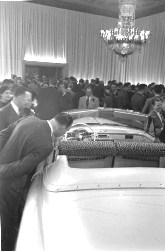 4 4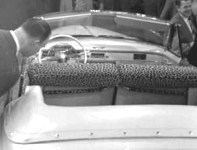
1. and 2. : Cadillac boss, Don E. Ahrens checks over
the "Debutante" at the NY Salon
3. and 4.: Could the tall gentleman leaning into the car be Harley J. Earl?
[ Images: LIFE Magazine ]
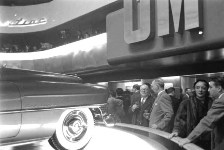 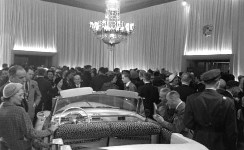 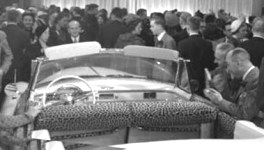
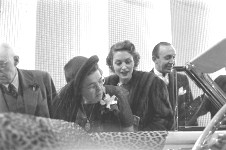 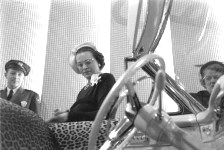
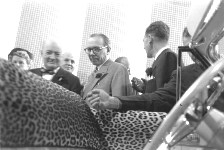
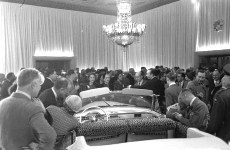 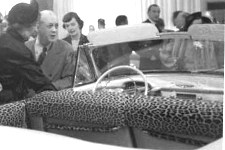 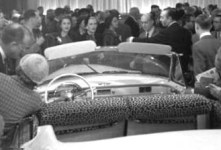
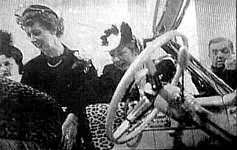 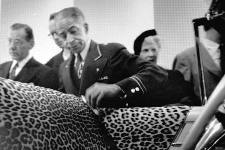 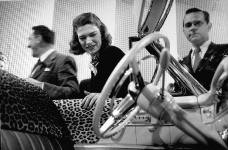
More photos taken during the NY Auto Show
[All images in these 4 rows: LIFE Magazine ]
Debutante trivia:
renowned artist, Salvador
Dali met GM President Harlowe Curtice, in Paris, during the Annual Motor
Show there, in October 1959. On that occasion, Ms. Curtice
lunched with Dali who convinced her he would be a good designer for a
Cadillac show car that, like the Eldorado Brougham (Pinin
Farina's Jacqueline ???) that was on display, might well be shown
one day in Paris. Cadillac Presidebt, Don Ahrens, later met Dali
at his hôtel particulier (typical French high-class luxury
apartment) to chat about such a possibility; he asked what Dali
might want as payment for such a design contribution; Dali said he
would be happy simply with "a Cadillac of his choice". A few weeks later,
Dali did send some drawings (I wonder if they survived?). His car was
clothed (like the 1941 models in two of his well-known paintings) in a
purple robe with gold tassels all round; it featured two paired sets of
windows; one offered the occupants total privacy, having the moon and
stars on the glass; it could be lowered so as to be street-legal. Dali
named his car the Debutante (the
name of the 1950 dream car shown here). Anyway, GM decided Dali's
proposal was not something they would want to actually build, even for
show; they duly retured the drawings. About a year later (1960?),
Curtice had a Buick custom-built for his daughter's coming-out party; it
too was called the Debutante.
No sooner was that Debutante announced than Dali wrote to
thank GM for adopting his name for the car and asking for an
Eldorado Brougham (1960 model?) as payment for "his" work. It is not
known how the case was settled but it is believed that Dali did get an
Eldorado Brougham. Ahrens was not sure that a design
inspired by Dali ever could have been used by GM or Cadillac. He said it
was conceivable, nevertheless, that Cadillac and Dali might well have
put something together, perhaps for a show, because Dali's work was
"tops" in his field.
Another press cutting of the time [ZTV collection] described this
car summarily as "The most luxurious car ever built by Cadillac, the new
Debutante convertible has leopard skin upholstery on the upper portion of the front and
rear seat backs, the upper side panels and the complete floor in the front and rear
compartments; lower seat backs, cushions and the coverings of the lower sides and door
panels are in a shimmering, opalescent gray nylon satin. Armrests are covered with
iridescent gray leather and all interior unpainted metal surfaces are gold-plated. A
leopard claw is added to the ignition ring." The article is accompanied by some photos.
Fleetwood (USA) [???] During the Grand National meet in
Denver, CO, August 2001, photos of this interesting and rare Series 60 Special
with partition and division glass were shown to me by Ron Van Gelderen, past president
(twice) of the Cadillac-LaSalle Club; it was built apparently for a GM official named
Albert Bradley. The car is bottle green and the interior has some olive green accents. It already
incorporates some 1951 trim as well as a Derham-styled back light and thickly padded roof.
Late Extra 2012: the car
came up for sale on eBay with this description: This Cadillac,
506074429, was built for General Motors executive Albert Bradley. At the
time it was ordered, Bradley was an executive vice president and
chairman of the Finance Policy Committee for General Motors. When Alfred
Sloan retired in 1956, Bradley became the Chairman of the Board and
served until August 31, 1958 when he retired. His career at GM began in
1919 and continued to be on its board of directors until 1972 [ ...
] As ordered, the car was a 1950 Cadillac Fleetwood 60 Special Sedan.
It was painted black (1) with a blue broadcloth interior (63). Extra
equipment included: windshield washers, license plate frames, four wheel
discs and passenger side mirror (Accessory Group B); Radio -
Syncro-matic with antenna and speakers (JU); Heater (B); and royal white
wall tires (RW). The car was sent to Styling Section for enhancements
after assembly. Christo Datini of the GM Heritage Center included a
scan of the car's build sheet for my personal research. It was delivered
to Bradley at GM's Columbus Circle HQ in NYC. Mr. Datini added:
"While I have Styling pictures of other Cadillacs built for Mr. Bradley
(1948, 1949, 1952, 1957), I do not have pictures of this particular car
that would have been at Styling in October/November of 1950.
Bradley was a fascinating character who lived in a huge manor home in
Greenwich, CT. You'll see him prominently featured in the big LIFE
Magazine article on GM, circa 1952, but he seems to be overlooked by
historians. Who knows whether he commuted to the city in his company
car(s), or was picked up at the station; either way, what a way to
arrive at work! As for the ebay sale, it's too late to change the
listing's flowery description as bids have been made, but the seller
could add the info I sent two days ago to the bottom of the listing.
Let's see if he does, or stays with the Harley Earl/ Alfred Sloan
puffery. I pointed out that the Tech Center didn't open till '56, but
it's quite possible that at its disposal the car's transaction was made
through the Tech Center where the car may have resided, neglected for
years. Since the last time I saw the car, the leather top has been added
and it's been given a good cleaning. It is believed that Styling grafted
the rear roofline of a Cadillac 75 aft of the B-pillar to the car and
made the unique rear door window trim [ ... ] The Cadillac is
beautiful and unique with a rich history, but having no title is going
to hurt its sale. Still, I hope it finds a good home.
[ photos needed ]
Ford built the body of this Fordillac,
powered by the 1950 Cadillac engine. American rally driver, Tom Cole, introduced
Briggs Cunningham to Bill Frick and Phil Walters in 1949; the letter pair built for
Cunningham a 140 mph Fordillac, with a Cadillac engine, brakes and a Borg-Warner Lincoln
transmission. Cunningham subsequently bought over Frick-Tappett Motors after the 1950 Le
Mans race in which two stock Cadillacs and a Cadillac-engined barquette nicknamed "Le
Monstre" [the "Monster"] did rather well. This car's engine kept running
throughout the Le Mans race in 1950 to keep charged the radio batteries operated by the
race team in the Cadillac pit.
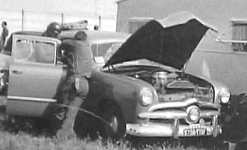
[ Photo : by Smith Hempstone Oliver ]
[Unknown, USA] Welfare Cadillac, the name given
to a black, customized 4-door sedan on show at a museum in Kansas, identified principally
by its "moon" wheel discs and front fender mounted horn trumpets.
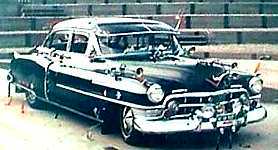
[Unknown, USA] Armored limousine for Argentine dictator, Juan
Perón. This was excerpted from an undated Detroit newspaper believed from the 1950-1951
period [ZTV collection]: One of the auto world's best kept secrets crawled into
the open Tuesday but there were still missing links in the story of an accessory-laden
Cadillac limousine ordered by Argentine dictator Juan Perón. The car is said to have a
refrigerator, air-conditioning, radio-TV, bullet-proof glass and a bar. The vehicle cost
approximately $11,000 completely equipped.
[Unknown, USA] Camper conversion on Cadillac chassis
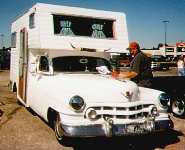
[Unknown, USA] Pick-up conversion on Cadillac chassis
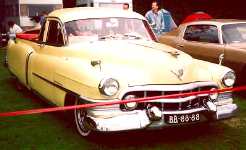 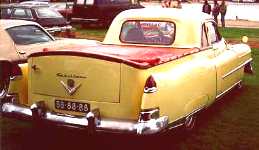
[ Photos: Internet, 2004 ]
[Unknown, USA] Hot rod style conversion of basic 1950 Cadillac
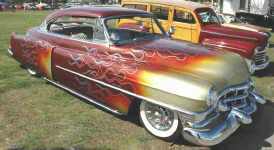
[Unknown, USA] A 1950 Cadillac coupe in the garb of a
Panamericana (Baja California) road race competitor
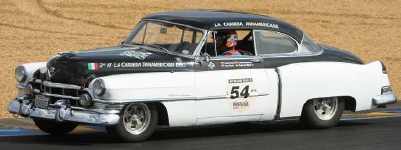
[Unknown, USA] A 1950 Cadillac roadster-racer of
unknown origin (possibly Hollywood Plastics of Glendale, CA). It was
found around 2009 and last registered in Califorrnia in 1950. Two
different power plants had been used but there were none on the car as
found. Chassis and rear axle are from a 1941 Cadillac Series 62 whereas
the front axle is from a late 40s Ford.
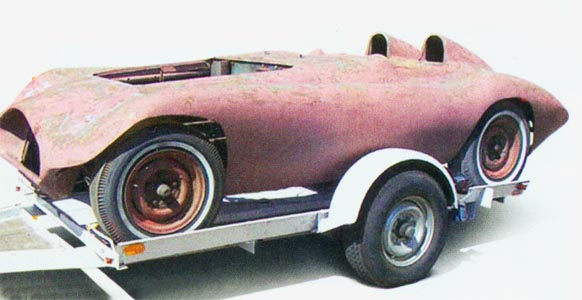
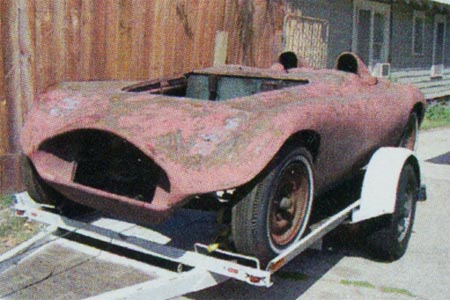
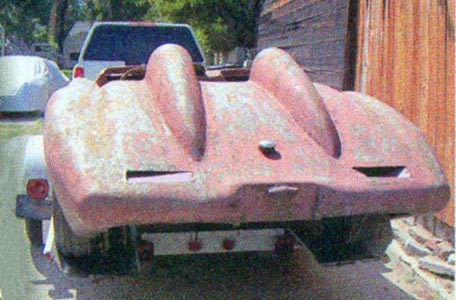
[ Photos: Bobby Fukumoto, c/o
Hemmings Motor News, May 2009 ]
[1950-51-52: unable to identify - can't see grille] (2) special
station wagons with wood paneling, one with razor-edged rear roof line, the other with
roof rack, six windows and small rear window ŕ la Derham.
[1950-51-52: (same again) unable to
identify year - can't see grille]
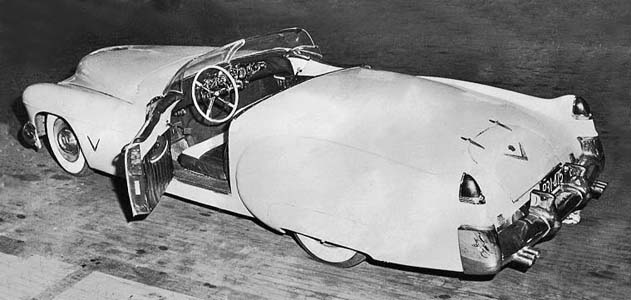
1951
Buick "XP300" (special order # 9864), Alfred P. Sloan
Museum, Flint, MI.
Allard (UK) Built a few J2, J2X and C2 racing barquettes powered
by Cadillac engines. Photo McC p.292.
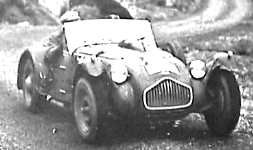
Coachcraft (USA) custom station wagon on Series 62 chassis
commissioned by Merril M. Madsen of Minneapolis, MN and designed by Philip Wright. The car
carried an ornate hood emblem representing two intertwined "M"s, the owner's
initials.
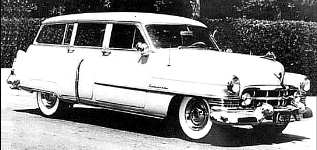
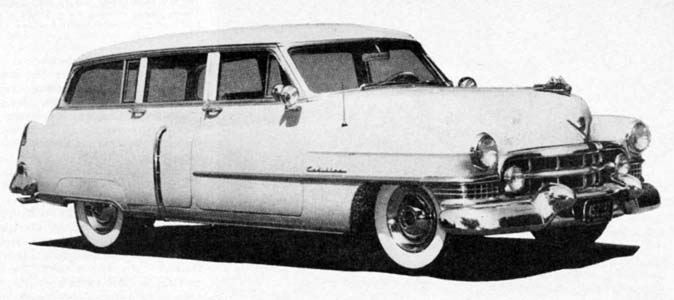
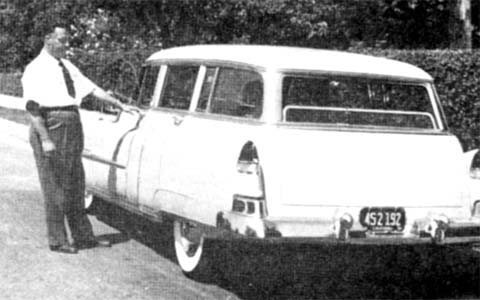
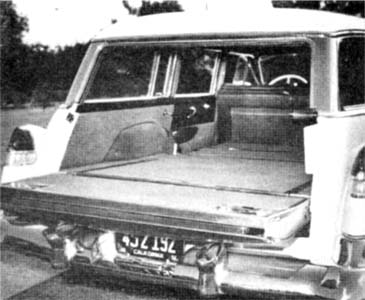
[ images (lower row): Z. Taylor Vinson collection,
courtesy Hagley Library and Museum, DE ]
Dean (USA) conversion on standard 1950
Cadillac
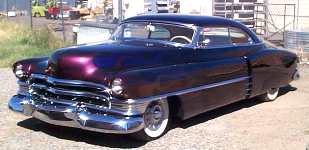
[ Photo: Internet 9/2001 ]
Derham (USA) conversion on standard Series 75 limousine, SSA
1992, pp.18-21. Its history is said to include Jackie Kennedy and some Hollywood names.
This car was offered for sale for $35000 in September 1996 [SS, 9/1996, p.19].
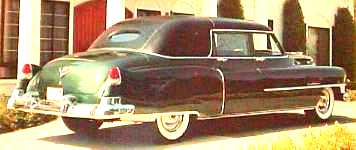
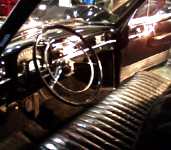 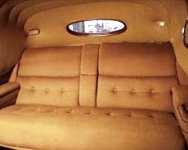
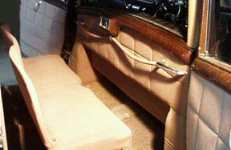
Derham (USA) conversion on standard Series 75
limousine, for the Firestone tire company estate. This car was offered for sale on
the Internet. Collector-enthusiast, Hank Howard told me in May, 2005: I
acquired in the past year the 1951 Series 75 Derham custom bodied limousine you have
photos of in your 'Dream Cars for 1951' section. I can confirm that the car was
built for Harvey Firestone and his family. It spent almost it's first 50 years on their
estate in Newport, Rhode Island.
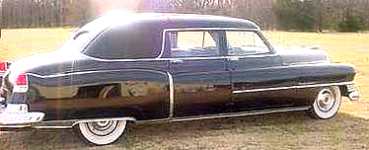 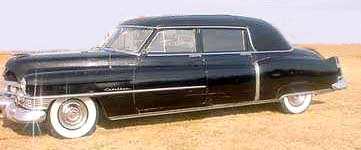
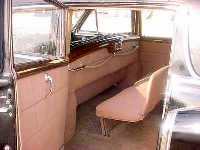 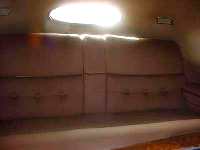 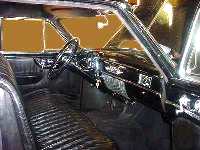
[ Photos: Internet 3/2002 ]
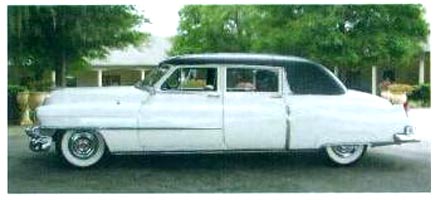
Here is another Derham conversion; it
came up for sale in the Self Starter in 2011
Fleetwood (USA) Specially trimmed Coupe de Ville
for GM President, C.E. Wilson. According to build sheet the car had gold plating
on the interior and some features for 1952 and
later Cadillac models ( features such as experimental a/c in trunk and the
new-to-come "Autronic Eye" headlight dimmer; it has also a 1952 rear bumper.
There are two SO [special order] tags on the firewall and the build sheet supplied by
Cadillac's Historical Services mentions special "Jones Dabney" black
paint (with gold flakes?) as well as a tan fabric top to simulate a convertible. The
last known owner
[6/2000] was trying to restore the car and wondered if there were anyone still around
who might
remember the car and in particular the upholstery material (it no longer has the original
fabric). The door panels (photo) have a special wood finish and the handles and power window
switches are again gold plated. Late Extra
(12/2014): the car was offered for sale on Craig's List for a
FIXED amount of $75,000. It was specified in the ad that the car is
rustfree and straight but needs a full restoration.
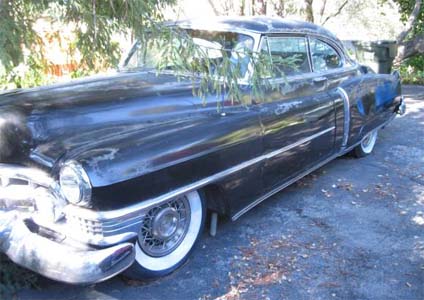
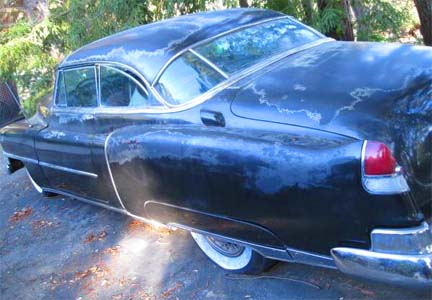
1953 "Eldorado" wire wheels ...or
simply optional wheel covers?
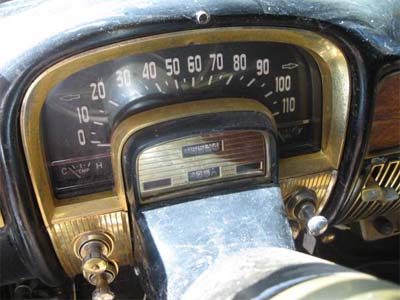 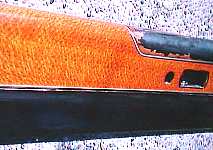
(Left) "Gold"-colored horse-shoe
instrument cluster
(Right) Upper front door panel in gold-toned marquetry
[ larger photos: Craig's List ]
Fleetwood ??? (USA) Specially trimmed 1951 series 62
convertible, style #6267XS [I have not seen this style number before, for any 1951
Cadillac listings]. The "X" indicates it was fitted with power windows and the
"S" that it was probably a "special order". The car currently
[4/2001] is located in India, where it previously belonged to a Maharajah. The
present owner Aniruddh Kasliwal (CLC member #16670) said this: "The new
Cadillac Database is wonderful and very informative. My Cadillac is also an ex - maharajah
car from the state of Gwalior, in central India. You could put that up also [done,
Ani]. I am sending you a photograph of the car [below]. The engine no is 9N
100409 [I do not believe that the initial two digits "9N" appear on
"regular" Cadillac engine numbers for 1951, but the #100409 does fall within the
range of 1951 engine numbers; these ran from 000001 through 110,340] and the
chassis number is 51 62 103486 [suggesting it was the 103,486th 1951 Cadillac out of
the 110,340 units built that year].
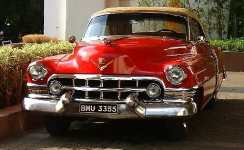
Ani's car has the gilded "V" and crest of
1952 "Golden Anniversary"
Cadillac models, as also the 1952 "winged emblem" below the headlights
Fleetwood ??? (USA) Upgraded Series 62
convertible (one of two so prepared and shipped to GM Canada for the
royal visit of England's Princess Elizabeth and her husband, the Duke of
Edinburgh (later Prince Philip), a couple of years before she acceded to
the British throne. It came to light during a Barrett-Jackson auction at
Palm Beach, in
2011, where it sold for $83,600 (inclusive of commissions). The most
distinguishing feature is the soft, transparent vinyl top for use in
inclement weather. There is a plaque on the dash attesting to the fact
that it was used by the royal couple during their 35-day tour of Canada
in 1951. The catalog description reads: Upgraded Series 62 convertible (one of 2 so prepared and shipped to GM
Canada for the royal visit of England's Princess Elizabeth, this handsome
1951 Cadillac, with its distinctive clear vinyl top, has a dash plaque
saying it was used as the Royal Parade Car, prior
to her accession to the throne, and the Duke of Edinburgh during their
35-day tour of Canada in 1951. Completely restored to original form, as
attested by the original GM invoice showing the car's shipment from
Detroit into Canada. Car has no other documents. This distinctive car
features a 331 CID V-8 engine with 4-barrel carburetor and larger
radiator to prevent overheating in parades, automatic transmission,
power steering, beige power top, power windows, and signal seeking
radio. The unique clear vinyl top, easily mounted by one person with the
canvas top stowed. This car is one of two known Series 62 Cadillac
convertibles used during the Royal tour. The Royal Canadian Mounted
Police drove the cars and provided security. At the conclusion of the
tour the RMP provided brass dash plaques, as affixed to this car's dash,
for those cars used by the Royals. Used sparingly, the car has been well
maintained in an environmentally controlled environment. The car’s
current owner, Alan Jackson of Purcellville, VA, said he bought the
Cadillac in North Carolina. The top is a skeletal aluminum frame with
clear vinyl that allowed both the Royals to stay warm and dry, and their
well-wishers to be able to see them.
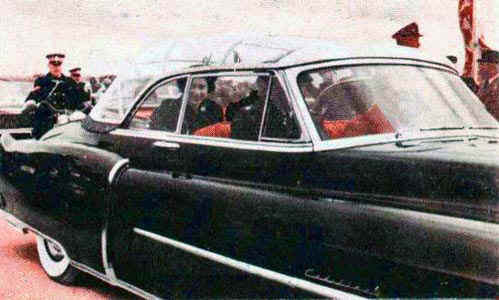
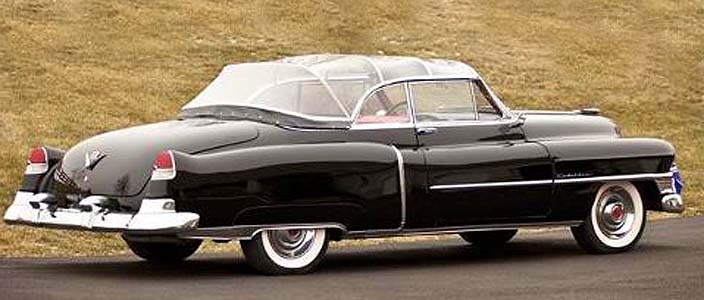
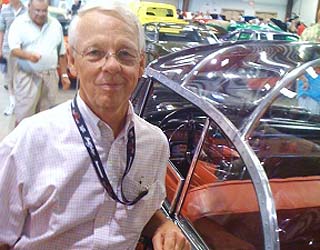
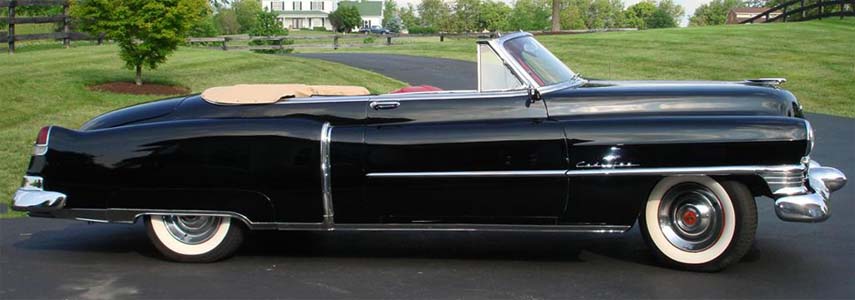
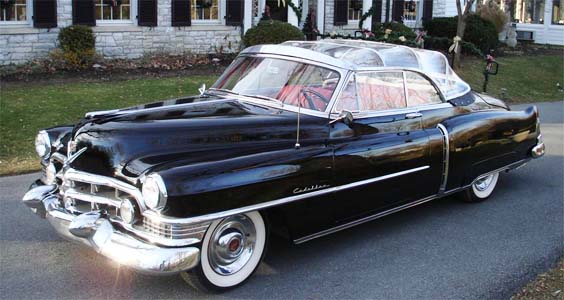
On a state visit to Canada in
1951, H.H. Queen Elizabeth II of the U.K. and Prince Philip
used this custom-built "bubble-top" limousine. More photos and a detailed
description
of the car are to be found in the
"Dream Cars" section of
the "Cadillac Database"
Franay, Coachbuilders (France) Royal "hi-top"
touring limousine project for H.M. Ibn Seoud, King of Saudi Arabia, to
be built on 1951 Cadillac commercial chassis. There is no pohotographic
record of this one having been actually built.
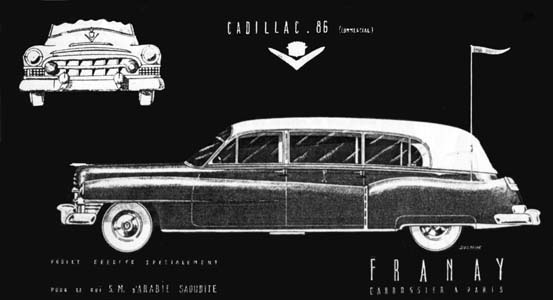
GM/Cadillac (USA) Strictly-speaking this is a Buick, not a
Cadillac. It is included here because it is the mother of all Cadillac dream cars
and show cars shown at the Motorama. Many production Cadillac models of 1953-1958 borrowed
from the styling of this machine. Named after the airforce's F-86 La Sabre
fighter jet, you may read all about this dream car, GM's 1950-51 "Le Sabre",
in SIA #158, cover and pp.20-27, 66-67. Here are
some dates to remember: in July 1946, ideas and sketches were
begun: in October 1948, full-size drawings were made; in December 1948,
the first parts of the actual car made; in March 1949, Mr. Earl named
his dream car Le Sabre; in December 1949, work began on the buck
and clay prototype (below); one year later, in December 1950, the
finished car was shown to the public; in March 1951, engine tests were
run on the completed car; in June 1951 a press release was published and
the Press attended a showing (below)
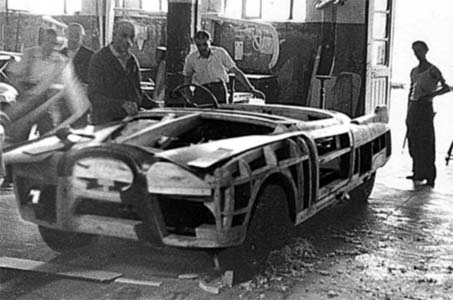
(Left) the wooden buck on which Le Sabre's
clay model was mounted
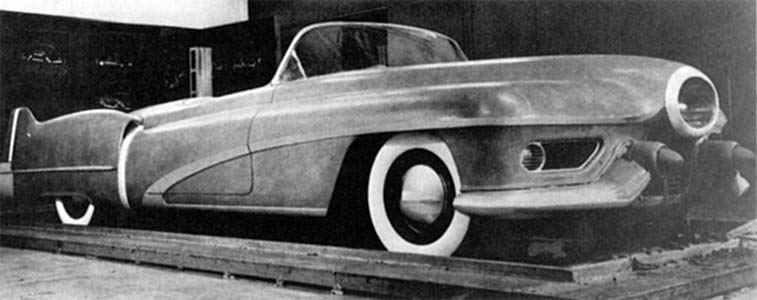
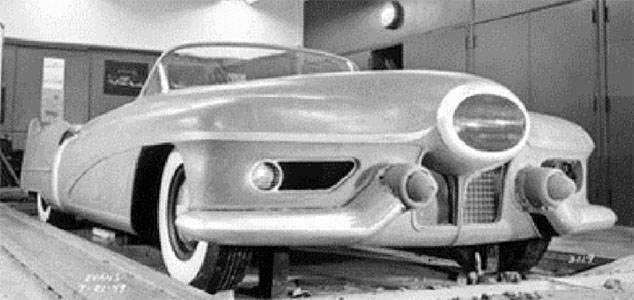
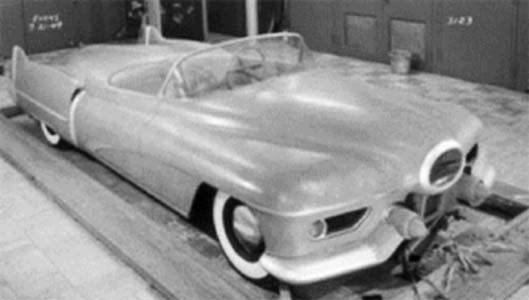
Above 3 rows: Early clay bucks; note
position of side lights
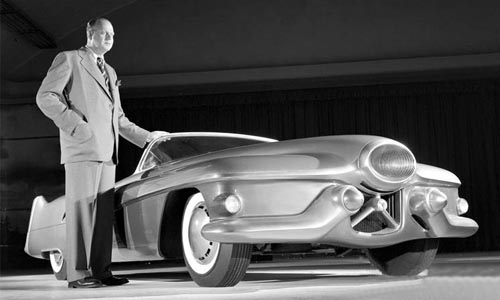
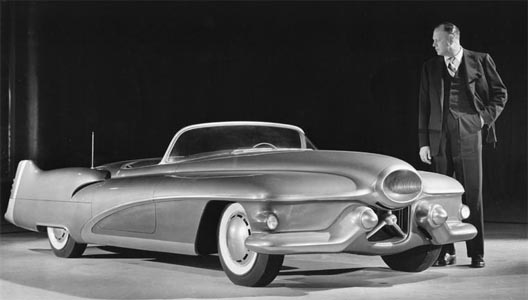
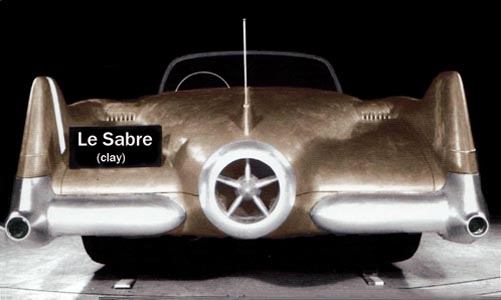
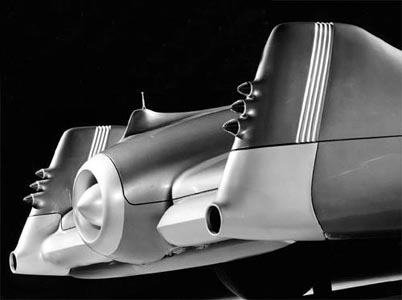
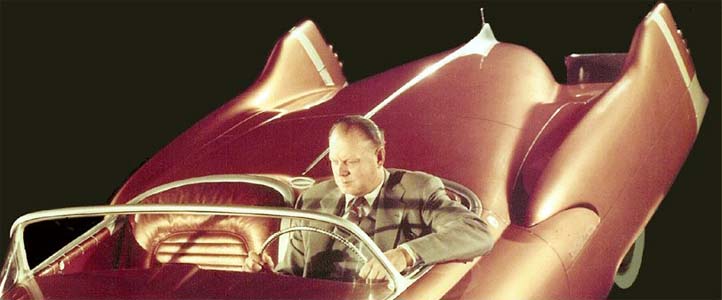
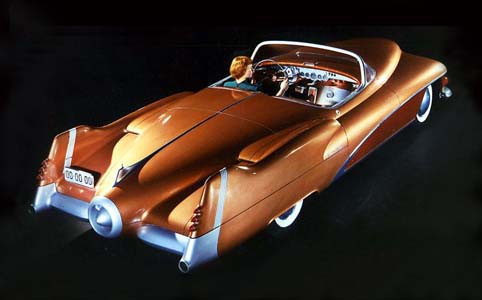
Finished prototype; the
original gold-brown hue was later changed to silver gray).
Le Sabre ... almost complete
and ready to roll
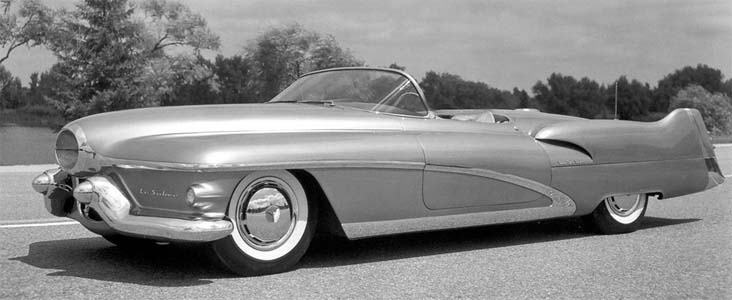
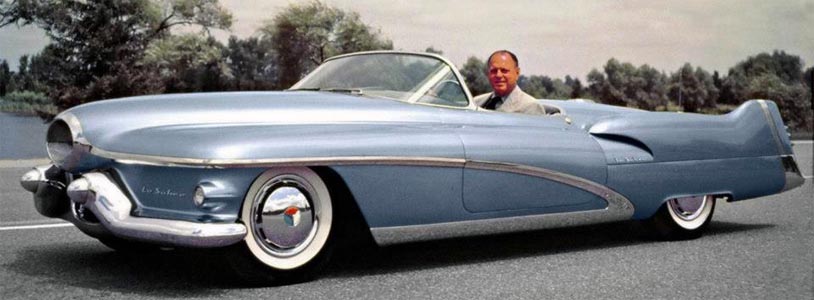
Color shot taken at the same spot as
RH snap, above, but with Earl himself at the wheel
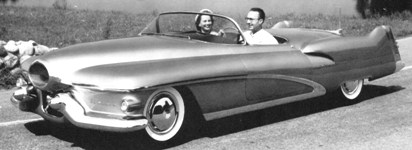
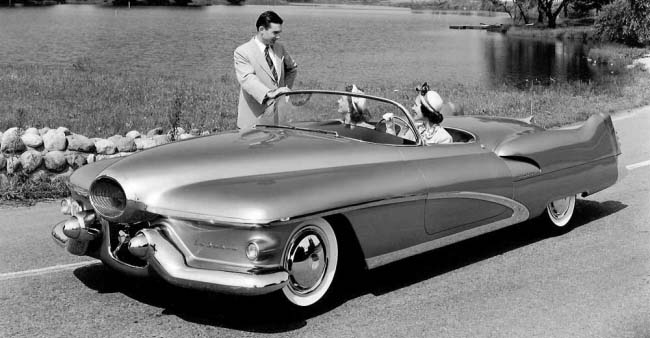
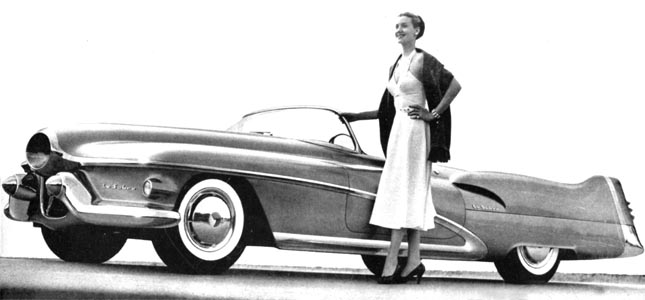
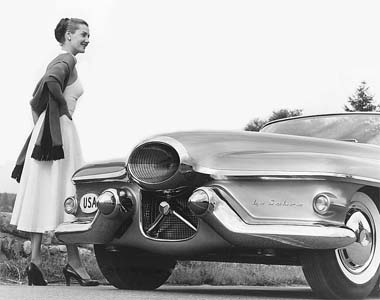
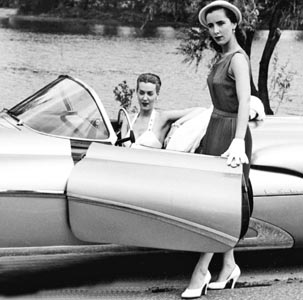
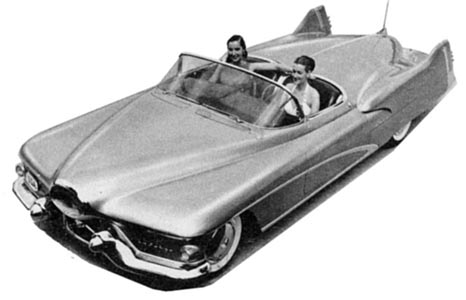
Right:
first trial spins
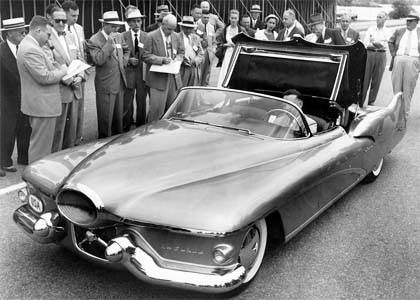
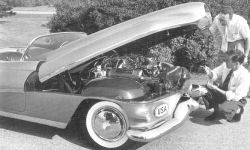 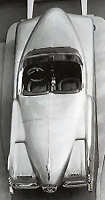
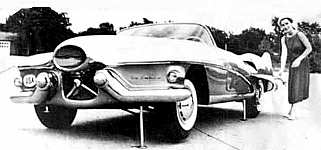
(Left) engine testing under way;
(center) a bird's eye view; (right) Model
demonstrates ingenious,
built-in hydraulic jacks (at each wheel) to facilitate wheel changing in case of a
flat tire;
the rear febder skirts could be raised to facilitate wheel removal
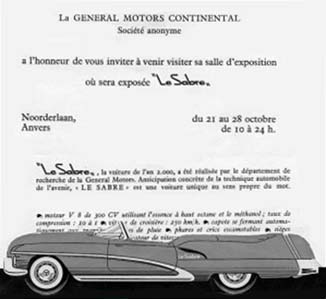
This invitation was issued in Belgium
by the GM agency at Noordlaan in Antwerp. The text reads:
GENERAL MOTORS
CONTINENTAL has the honor to invite you to visit the exhibition hall
where Le Sabre will be on display from 21 to 28 October
[1951] from 10 a.m. to midnight; Le Sabre, the car of the year 2000, was
built by General Motors' research department.
She is the embodiment of automobile techniques of the future. LE SABRE
is a unique automobiles in the proper sense of the term
[specifications and a description follow but are partly obliterated by
the line drawing of the car placed below the text]
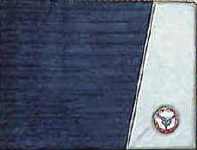 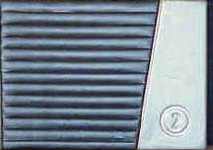
Special Le Sabre photo albums were prepared for GM's CEO, Harlow Curtice; I
got to view and photograph the main
album (left)
when I visited the Design Center in Warren, MI, in 1994; the other album, right, is a pictorial
record of
Le Sabre's promotional tour overseas in 1950 (France and Belgium were
on the itinerary)

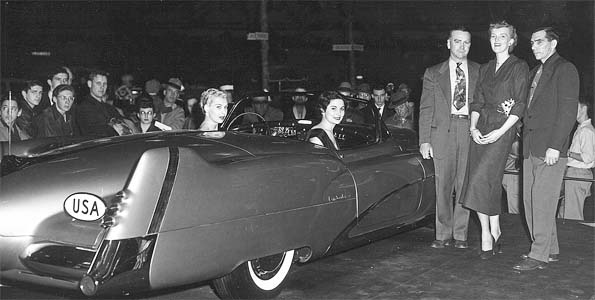
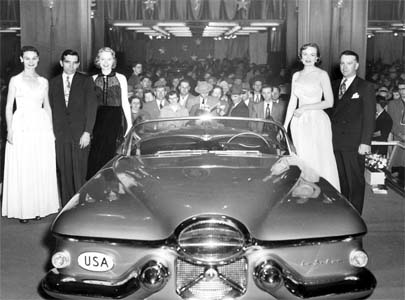
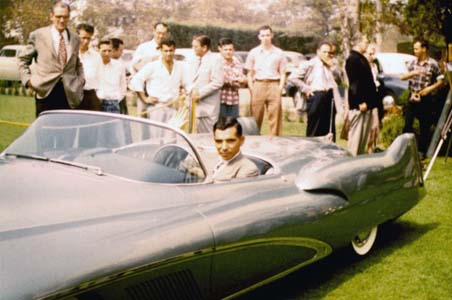
The man in the driver's seat is Art
Carpenter; he is seen also is the two (B&W) photos, above, in company
with some lovely
models; the color photo was snapped during
a 1952 tour of the US' top universities (Cal
Tech, USC, UCLA, Stanford and the Art Center college, a small school
with which Harley was closely associated;
he helped start there the "Car Design a.k.a. Transportation Dept.");
Carpenter traveled extensively with Le Sabre, in company with
Leonard McClay
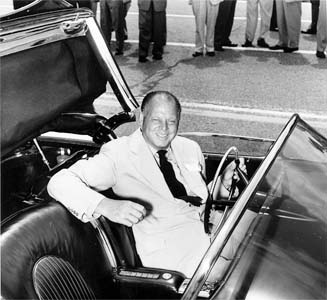
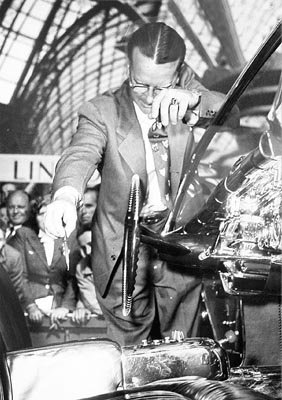
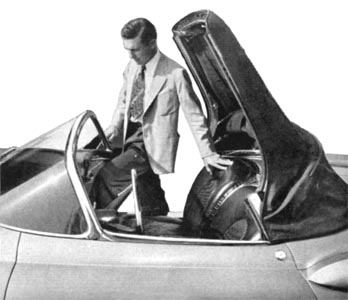
Left: Earl holding water pipette in RH
demonstrates automatic opening of soft top
Center: Same demonstration is made by GM representative during the Paris
salon
Right: the soft top opens automatically when a droplet of water hits the
console-mounted sensor
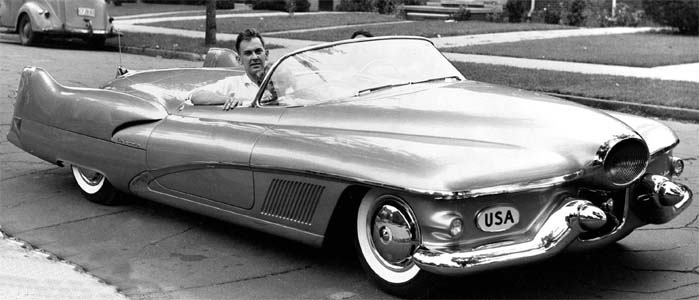
Note the different front fender
louvers on this version of the original prototype
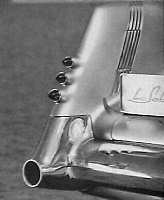 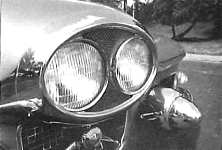
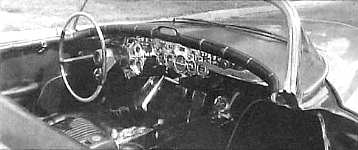 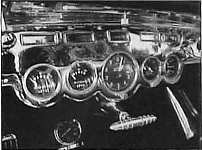 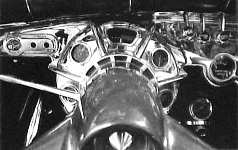
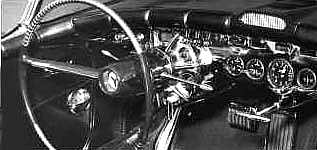 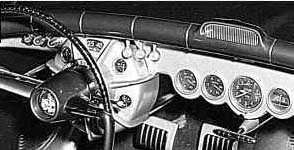
These 2 rows: instrument panel and instruments
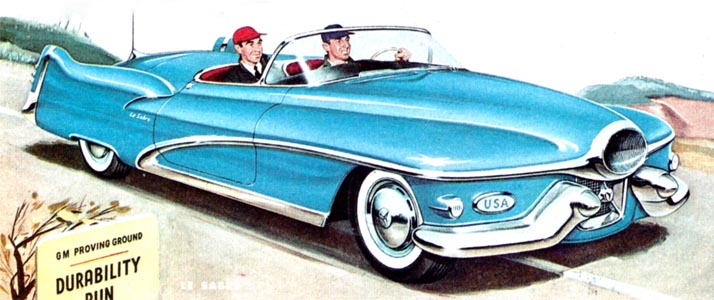
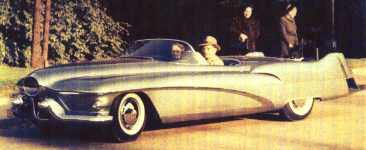 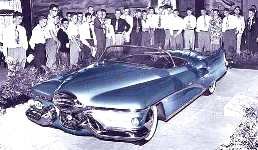
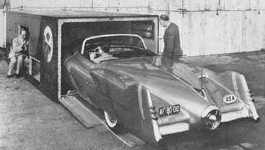 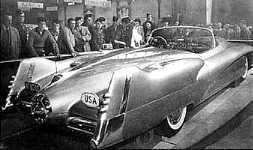
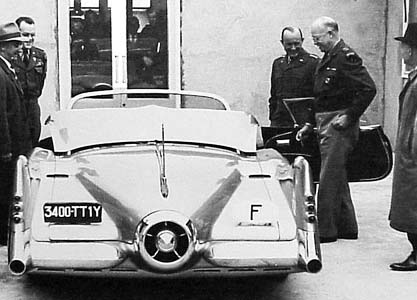
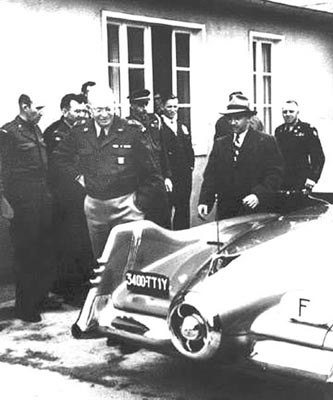
Left: Le Sabre meets the
press; right and center: in Fontainebleau, France, Ike Eisenhower inspects Le Sabre on a
visit to SHAPE in 1950
[SHAPE = Supreme Headquarters of the Allied Powers in Europe - where I
failed to make the grade as a French-English interpreter, back in 1961]
Ike enjoyed a demonstration of the car's automatic top, activated by a
single drop of water on a sensor located on the car's console;
accompanying the Supreme Commander of the allied powers were Gal. Gruenther
(Chief of Staff) and Mr. P.W. Copelin (Managing Director, GM France
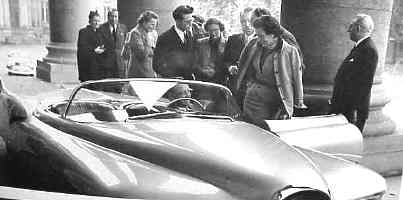 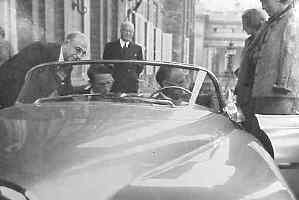 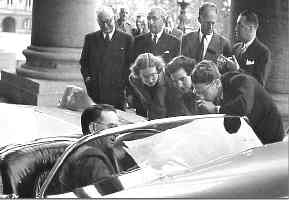
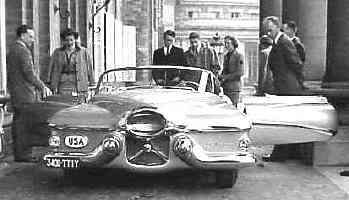 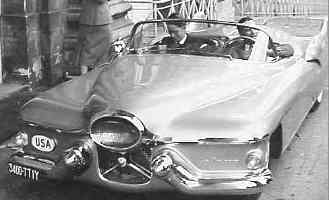 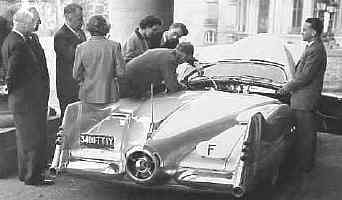
King Leopold and future King Baudouin of Belgium
admired the car in Brussels
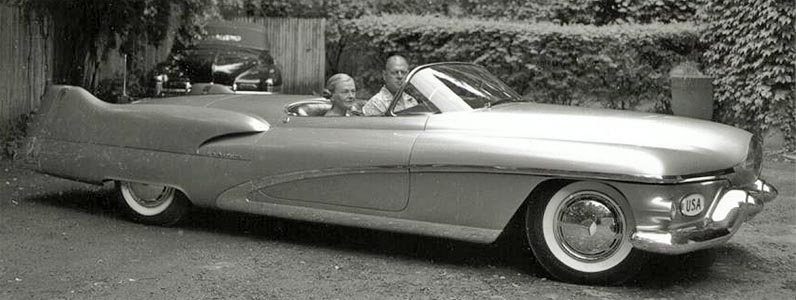
Back from their European tour, Mr. & Mrs. Earl
(Harley & Sue)
continue driving Le Sabre when they take up
their US residence at 217 Touraine Rd. in trendy Grosse Pointe, MI
(Grosse Pointe News, July 1951)
(in the background, left, you can just make out the nose of Earl's 1938 Y-Job)
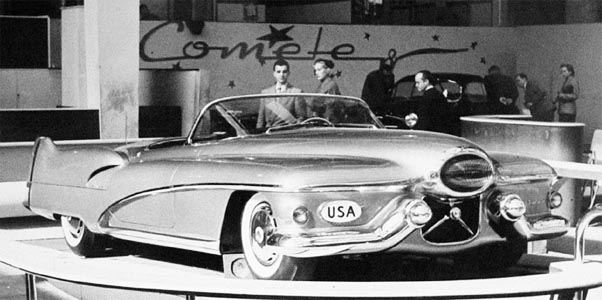
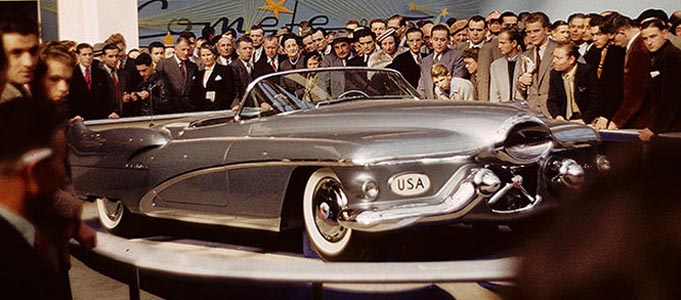
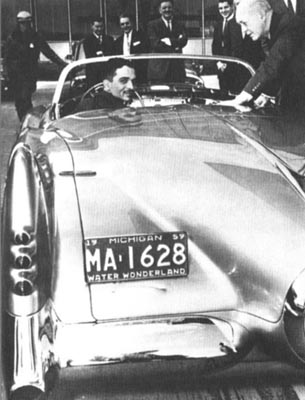
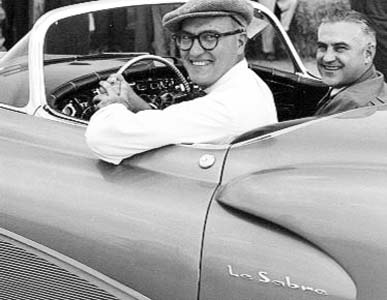
(Left) the late King Hussein of Jordan at the wheel;
(Right) Dave Garroway of
NBC is in the driver's seat; his passenger is Maj. General Robert W.
Burns, deputy vice chief of staff for the U.S. Air Force.
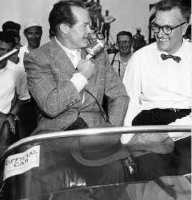
Bob Hope, the
actor and comedian, is seen here riding atop Le Sabre in company with
NBC's Dave Garroway;
the venue was Andrews Air Force base near Washington D.C.; the date: May 2, 1954;
Hope amused the
fans (as ever) with an off-the-cuff, impromptu monologue.
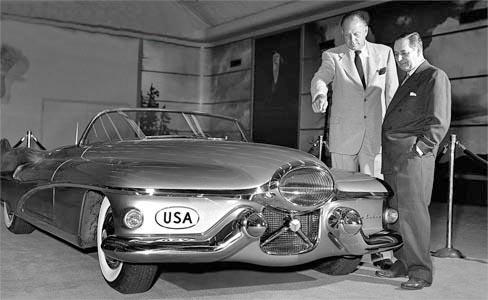
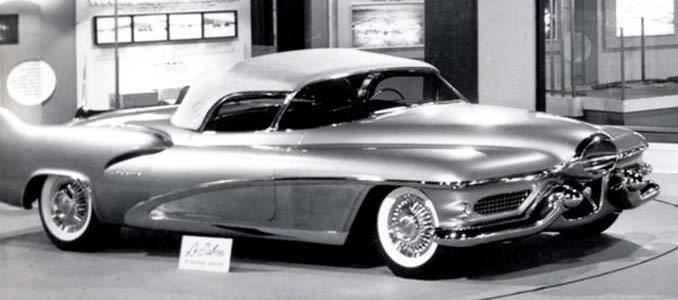
The car was on show at a number of
Salon venues, as this appearance at the 1953 Chicago Auto Show; note
open rear fender wells,
redesigned wheel discs (used later on Cadillac Eldorado
from 1955 to 1958) and new front grille openings
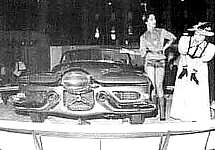 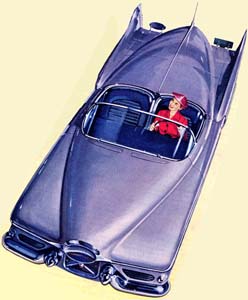
When did those vent grilles first
appear?
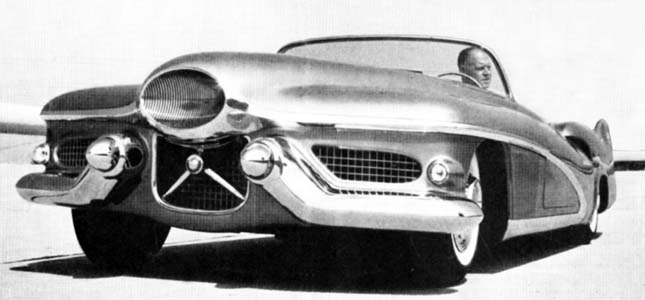
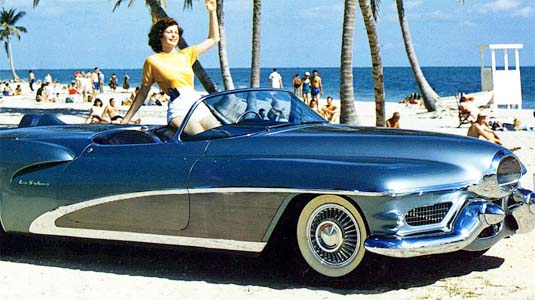
The car is
shown here with the new "turbine blade" wheels frequently seen on later
Cadillac
custom jobs; other updates to Le Sabre as seen here include new
open rear fender wells and front grille
openings ... although the latter were seen already on the early clay
prototype
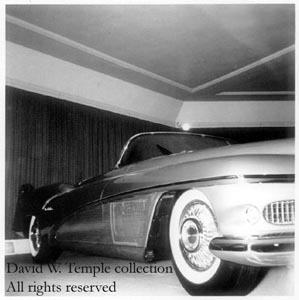

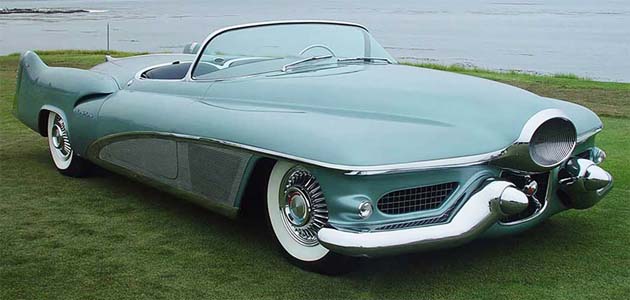
On show at Pebble Beach, the updated
Le Sabre strikes a dramatic pose ...
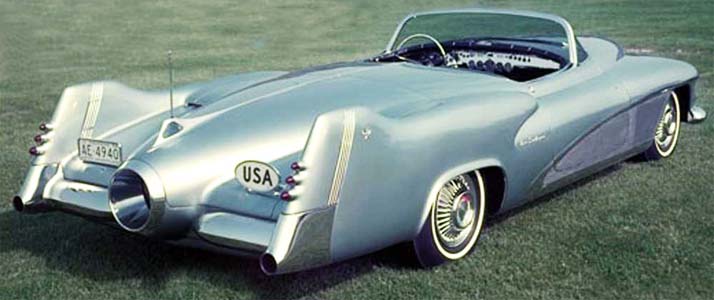
... matched only by this rear view,
shot at the GM Technical Center in Warren, MI
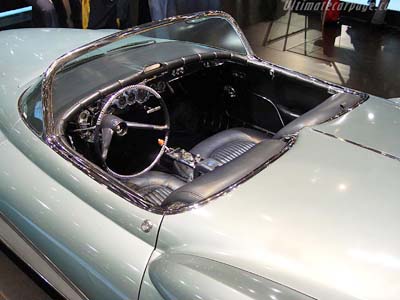
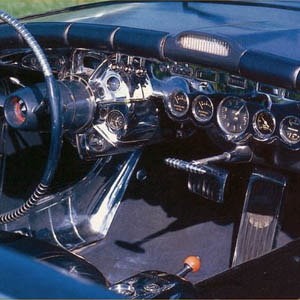
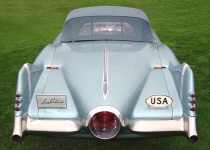 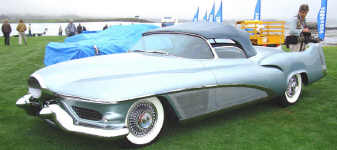
Le Sabre with top up, at a car show in 2003
[ Photo: © 2003, Ralph Kesting of Classics.com ]
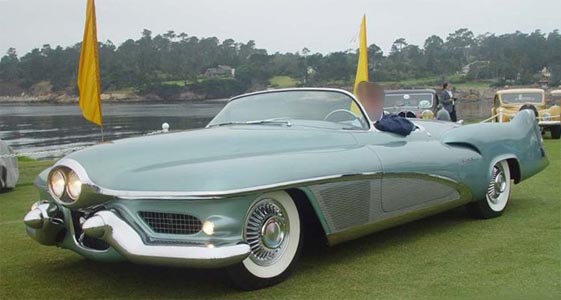
The car is rarely photographed, as
here at Pebble Beach, with the headlights and tail-lights on
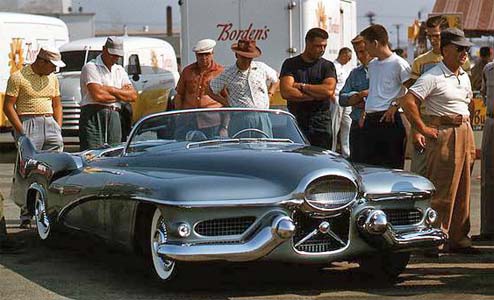 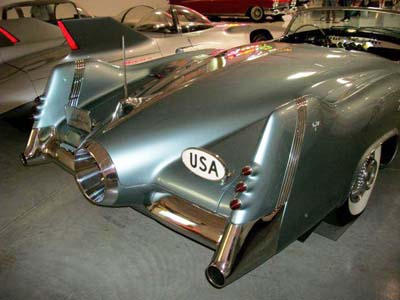
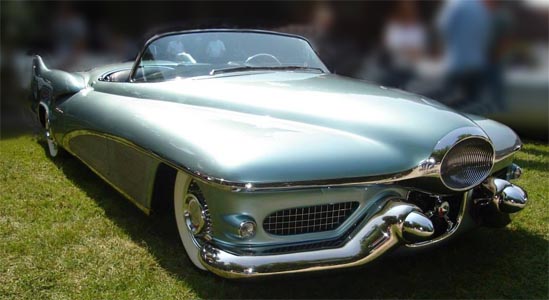
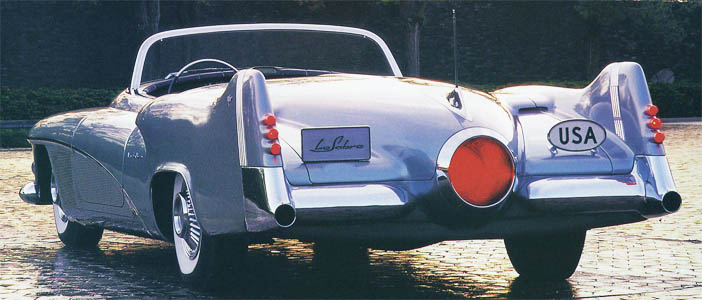
"Fake" Le Sabres
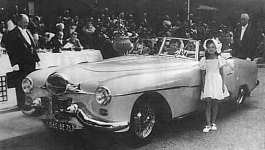
French-built miniature Le Sabre, built on the Salmson chassis I
believe)
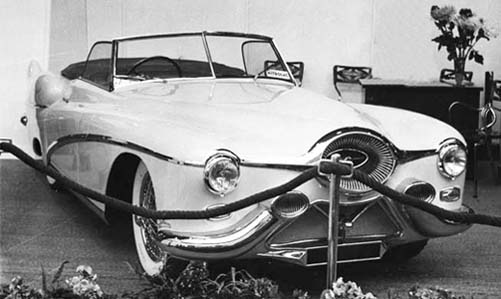
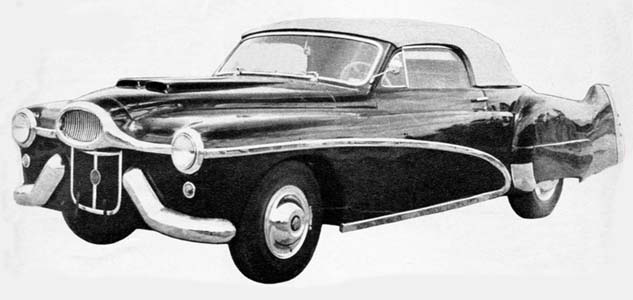
These two were built in Ravensburg.
Germany, by Hermann Spohn; he converted many other American cars owned
by US servicemen in Europe in the early fifties
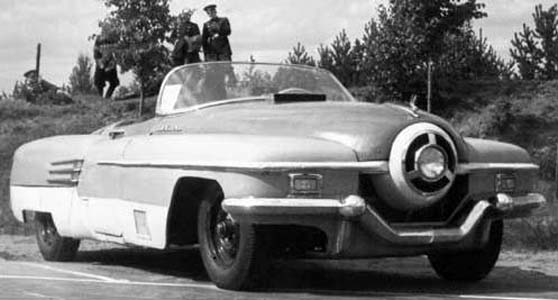
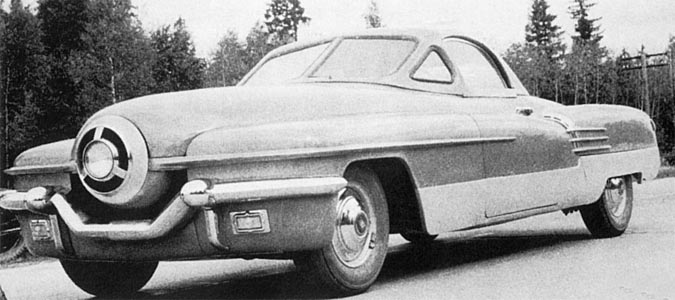
These (Soviet) Russian "Le Sabre"
lookalikes obviously were inspired by GM's prototype Le Sabre ... or was it the Tucker?
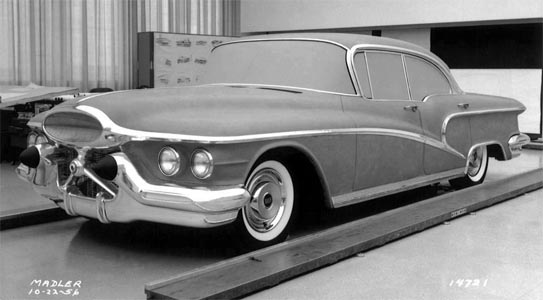
This GM-built clay prototype from 1956
was inspired by the original Le Sabre;
it was photographed by GM-Cadillac's own photographer, Neil Madler on
October 22, 1956
GM Canada (Canada) A mildly customized Series 62 convertible was
provided by the Canadian firm for the Canadian Royal Tour of Britain's Queen Elizabeth and
Prince Philip. Modifications included masts mounted at the front to fly the royal
standards. Photo, McC p.292
Hess & Eisenhardt (USA) King Ibn Saud of Saudi Arabia
ordered 20 new Cadillacs with custom-built bodies at a total cost of $250,000 (around
$12,000 each). This description of the cars appeared in TIME magazine for
February 25, 1952: Saudi Arabia's polygamous old king Ibn Saud
takes good car of his wives both past and present, Last week, a
Cincinnati hearse manufacturer showed off a new $250,000 present the
King is buying for his four present and some 100 former wives - 20 new
Cadillacs with custom-buit bodies to make them desert proof and
peekproof. The King will use them to carry his wives between the twin capitals of Riyadh and Mecca. Each car has
six doors,
accommodates six wives (plus chauffeur and attendant), has electric fans,
[and] special windows so the women can see out but no-one can see in.
For himself, Ibn Saud is getting a $20,000 mahogany-paneled trailer from
Tulsa, Okla., which has a throne room (with a 5-by-7-ft bed) and an
elevator to load & unload the King in his wheel chair.
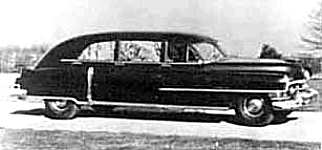
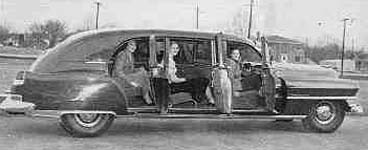 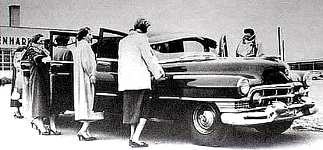
The person who appears to be standing behind the open
rear door (RH photo) has no legs!
In fact, she is the mirror reflection of the person in the light coat
standing between the two doors
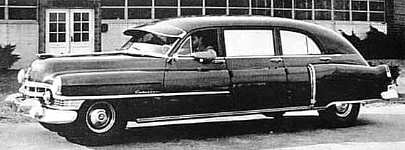
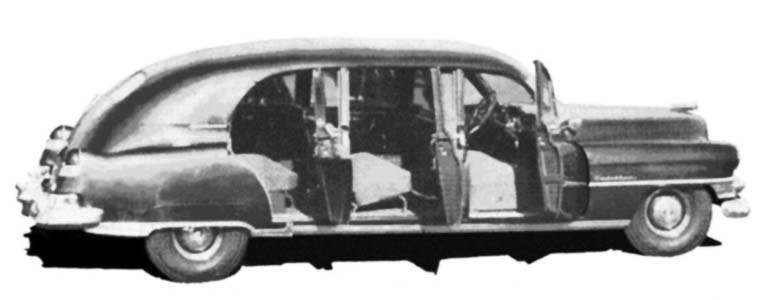
[Unknown, USA] Among the designers of this low-riding 1951 custom
convertible were Jesse James, Darrel Starbird and Billy Gibbons of ZZ Top fame
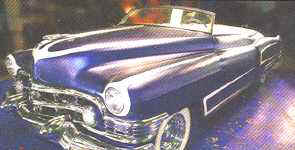
[ Photo: Barrett-Jackson auction catalog for Jan.,
2008 ]
[Unknown, USA] customized limousine with TV installed at a cost
of $1000 [excerpt from Chicago newspaper, March 29, 1951 - ZTV collection]
[ no photo available ]
[Unknown, USA] custom "rods" on 1950-51 Cadillac
chassis
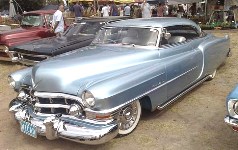
[Unknown, USA] Here's another low rider
that's been chopped, channeled and nosed; it was offered for sale in Hemmings Motor News
for Dec. 2007
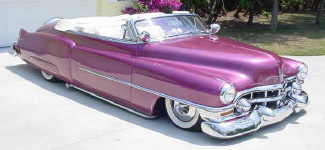 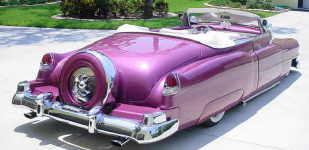
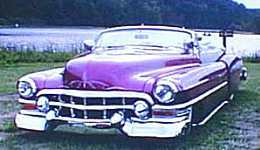 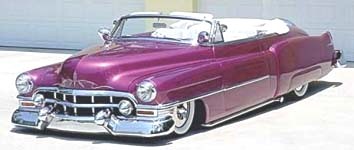
Images: Internet, 2010
[Unknown, USA] custom station wagon on Cadillac chassis; the
illustration below is from Mechanix Illustrated for December, 1951.
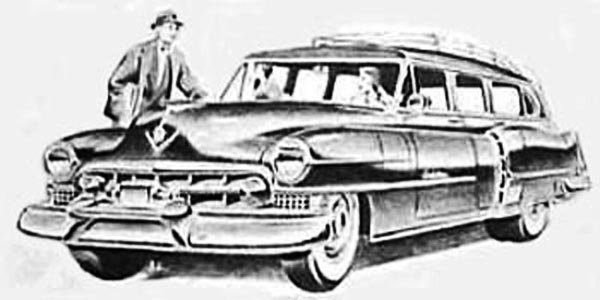
Shades of things to come from Hess &
Eisenhardt...
[Unknown, USA] this ad was sent to me by as vendor: customized
...1951 Delivery * RARE * UPDATED .... have many pics, Camaro sub-framed, 4 wheel
disc brakes, 33x19.5x15 M/T on Centerlines, 9 inch ford read end on ladderbar set-up, tilt
- power steering, 3 inch Dual exhaust, 350 Race motor, w/ turbo 400 trans, RUNNING &
street legal and yes it was a hearse ( no motor ,, trans, or electronics.. $4500.00 ) or (
$9200.00 Running ) lots of pics DrRace55@yahoo.com Houston, Texas
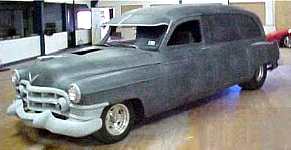
[Unknown, USA] Here is an example of a 1951-52 Cadillac equipped
with an after market Continental kit.
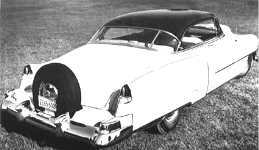
[Unknown, USA] This interesting
camper was built around a 1951 Cadillac commercial chassis (original
from Superior Coach Corp.)
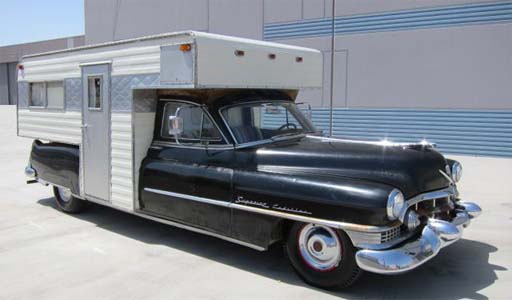
[Unknown, USA] Another, similar
camper, possibly built on the Cadillac commercial chassis of this year
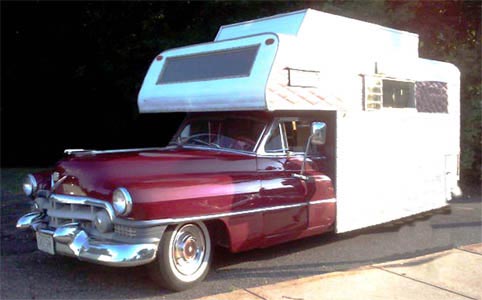
Van der Stricht, Patrick (Belgium)
Patrick is a devoted Cadillac enthusiast. This is his artist's proposal for a
1938-39-40-41-48-49-51-53-54-55-56-57-58 custom Eldorado coupe (...and I may even have
missed a couple of years in my speedy examination of this delightful drawing!

Drawing courtesy of Patrick Van der Stricht
1951-1952
Derhamy (USA): Custom Series75 limousine.
You can just make out the Derham script logo at the trailing edge
of the hood.
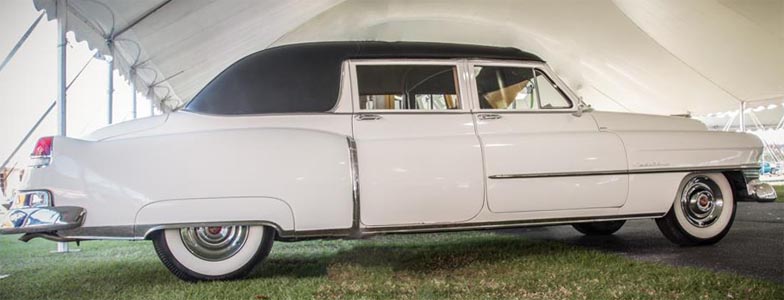
[Unknown, presumably USA] Two-door, two-seater convertible
[Unknown, presumably USA] Two-door, two-seater convertible
|